I’m glad you’re here today. After some (many) frustrations with making angel food cake, I have put together an angel food cake troubleshooting guide I hope you’ll find useful.
Angel food cake is made using the egg foam method, and it’s one of the only American style cakes that is almost completely fat free.
Read on to learn more!
Another post you might like is my friendly baking troubleshooting guide.
For ease of browsing, here are all of my posts about pastry methods in one place.
And if you need more cake, because who doesn’t need more cake? Here are all of my cake recipes in one place.
Thanks for stopping by!
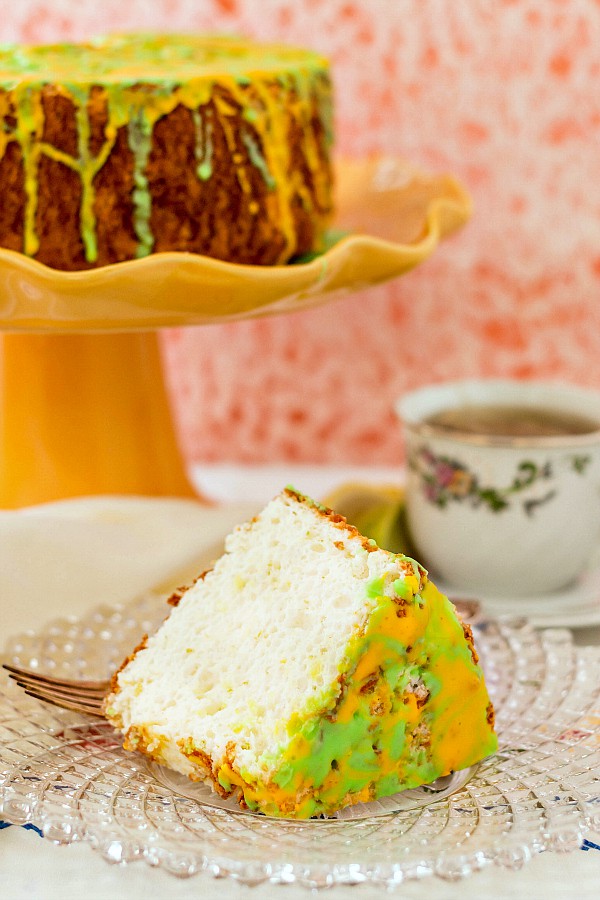
Perfection Sometimes Takes a Lot of Tries!
The first time I made angel food cake, I had a few issues. So I’ve put together this troubleshooting guide to help you avoid my mistakes.
For the first two tries, I based my recipe on this recipe from King Arthur.
I’m not saying this is a bad recipe–that wouldn’t be fair.
Pastry Chef Online Participates in Affiliate Programs. If you make a purchase through one of my links, I may earn a small commission. For more information click to read my disclosure policy
What I am saying is with two tries, I wasn’t able to achieve fluffy angel food perfection using this recipe.
You may have different results, and it has obviously worked for other people. Just not for me. Sigh.
Also, I want to point out that I didn’t follow their recipe exactly.
In Search of the Perfect Angel Food Cake
The first cake tasted great, so yay for that. But the texture was too chewy. The crumb looked more like bread than cake.
Maybe I overmixed it? Maybe there wasn’t quite enough sugar to tenderize it?
I think using cake flour is a better bet than using all purpose. Gluten is not our friend with angel food cake.
Since they contain zero fat (more or less), angel food cake needs plenty of sugar to keep them tender.
I also think I made a serious error by adding the citrus zests in with the egg whites. (I was making lemon lime angel food cake. Recipe coming soon!)
I think the amount of oil in the zest inhibited the foaming action.
A tiny bit of fat really doesn’t make an enormous difference like everyone tries to scare you into believing, but the amount of citrus oil in the zest of 5 fruits was maybe a bit more than my whites would let me get away with.
If At First You Don’t Succeed…
Round 2. Same recipe. Different procedure.
I used cake flour. I added all the zest in at the very end and folded everyone together.
The cake tasted great; the texture was definitely better, but the cake sank a bit while still in the oven, and the sides and top were wet once it had finally cooled and I depanned it.
What is up with that? Wet cake? Gross.
I think that, whatever happened to make it sink also ended up squeezing some of the water from the egg whites out of the mix. Sigh.
Round 3
After some crowd-sourced troubleshooting on facebook, my friend Janice Mansfield told me that the ratio she uses to make an angel food cake is 3:3:1 whites:sugar:flour.
Using that formula, I went with 12 oz each of sugar and egg whites and 4 oz of cake flour. And guess what? Success!
I love a good ratio, and I’m here to tell you that this one really works.
The Ratio Is Important
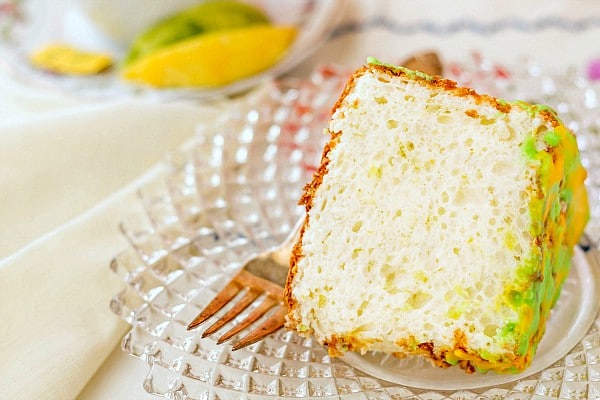
The magic ratio of 3:3:1 works.
This is great news, because now you can make a small angel food cake or a big old angel food cake with the same ingredient list.
All you have to do is change the amounts and stick to the ratio.
For a “full-size” angel food cake made in a standard aluminum footed angel food pan, you’re looking at 12 oz each of whites and sugar and 4 oz of cake flour.
Need a half-size (6″) angel food cake? No problem. 6 oz each egg whites and sugar and 2 oz cake flour.
If you don’t already own one, please buy a kitchen scale so you are absolutely sure that your ratios are correct.
Remember the ratio is 3:3:1 by weight, not volume, so a scale is really necessary to ensure best results.
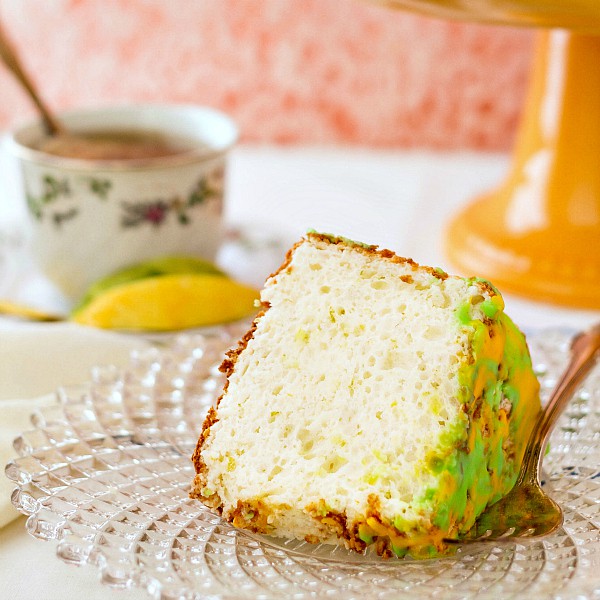
After all my trials and errors, I feel pretty confident about making an Angel Food Cake Troubleshooting Guide.
And here it is.
The Importance of Getting the Whites to the Correct Texture
This issue alone could be cause for many problems with your angel food cakes.
If you beat the whites to stiff peaks, they won’t be able to expand further in the oven. So, take your whites to medium-stiff peaks–the peaks should bend over when you hold the whisk upright.
Note you will further “whip” the whites when folding in the flour, so be sure to use a very gentle hand.
And this is another good reason to stop beating short of stiff peaks.
Flavor Ideas
Of course, you’ll probably want some flavoring.
Traditional is vanilla with maybe a touch of almond extract, but feel free to try out other extracts, or even add cinnamon or ginger.
Note that since angel food cake is pretty lean, there’s a negligible amount of fat to carry the flavor, so most angel food cake is fairly mild.
To make a chocolate angel food cake, simply replace an ounce of your cake flour with an ounce of cocoa powder. Be sure to sift the two together very well so your cake doesn’t have streaks.
For Best Results
Here are some Rules about getting your angel food cake right the first time, followed by the troubleshooting guide.
DO
- Use an un-coated pan. Plain aluminum with a removeable bottom is best.
- Whip whites to medium-stiff peaks. For best results, use a hand mixer or stand mixer. Now is not the time to be a hero and whip the whites by hand!
- Use a light hand when folding in the flour
- Always sift the flour to lighten it and to incorporate it more easily into the whites
- Bake at 325F, the sweet spot for angel food cake.
- Invert the cake pan to cool
PRO TIP: If your angel food pan doesn’t have feet, invert the tube pan over a soda bottle so air can circulate around the entire cake.
DON’T
- Bake in a non-stick pan
- Whip egg whites to stiff peaks
- Whisk or stir in the flour. Use a large spatula to gently fold in your flour.
- Bake in a too hot or too cool oven
- Use old eggs. Fresher whites means a more stable foam and less weeping.
- Cool the cake upright, or it could (probably will) collapse, at least partially.
How To Remove Angel Food Cake from the Pan
Since you’re not going to be oiling your pan or using a coated pan, the cake will stick.
And that’s what we want. The batter can “grab” onto the sides of the cake. This is what helps it rise.
So, once your cake is cooled (inverted, yes?) completely, run a thin, serrated knife down around the inside of the pan to loosen the side.
Carefully remove the sides, and then use your knife again to gently “saw” between the base and the bottom of the cake.
Then, gently lift the cake off the base and place it on a cake plate.
PRO TIP: A serrated knife is the best tool for cutting angel food cake. Gently saw rather than pressing straight down to keep your cake from tearing and/or getting squashed.
Need to Brush Up on Other Mixing Methods?
You may find my posts on The Creaming Method, The Muffin Method, The Biscuit Method, and the Two-Stage Mixing Method helpful.
And to find an overview of all of these methods as well as links to recommended equipment and books, I think you’ll find my Mixing Methods overview to be of use.
These mixing methods are foundational baking skills, and learning how to do them by heart can free you up from always being tied to recipes.
Questions?
If you have any other questions about angel food cake troubleshooting or any other baking/pastry questions, please don’t hesitate to get in touch.
You can leave a comment here, and I will be back in touch in about 24 hours.
If your question in more urgent, you can email me and I answer within about 4 hours.
Either way, I promise to help!
It will help me and other readers so much if you take a moment to rate and leave a review for this recipe.
You can use the stars to rate 1-5 (5 is best), and leave a review in the comments. It helps me make adjustments if any are needed, and comments help others decide whether the recipe is worth making.
Other ways to share include pinning, and/or sharing on your favorite social media platform.
Thank you so much for taking the time!

Angel Food Cake Troubleshooting Guide
| Problem | Possible Causes/Solutions |
|---|---|
| Cake's Texture is Too Coarse | Not Enough Sugar Whites under- or over-beaten Too much gluten in the flour (use cake flour) |
| Cake Doesn't Rise | Egg Whites Over-beaten Oven not hot enough Grease pan--you need an ungreased pan. |
| Cake Sinks in Oven | Egg Whites Over-Beaten Oven temperature too low |
| Outside of Cake is Damp after baking | Egg Whites Over-Beaten Old Egg Whites. Fresh whites don't weep as much as older whites. |
| Cake Sinks While Cooling | Cake not inverted to cool |
| Cake Overly Domes and Short | Oven Temperature too high. The sides set before the whites achieved optimum rise |

Hi, y’all! I hope you’ve enjoyed this post and hopefully also learned a thing or two.
If you like my style, I invite you to sign up for my occasional newsletter, The Inbox Pastry Chef.
Expect updates on new and tasty recipes as well as a bit of behind-the-scenes action. I hope to see you there!
I hope this guide helps you successfully troubleshoot all your angel food cake issues.
Thanks for reading. Take care, and have a lovely day.


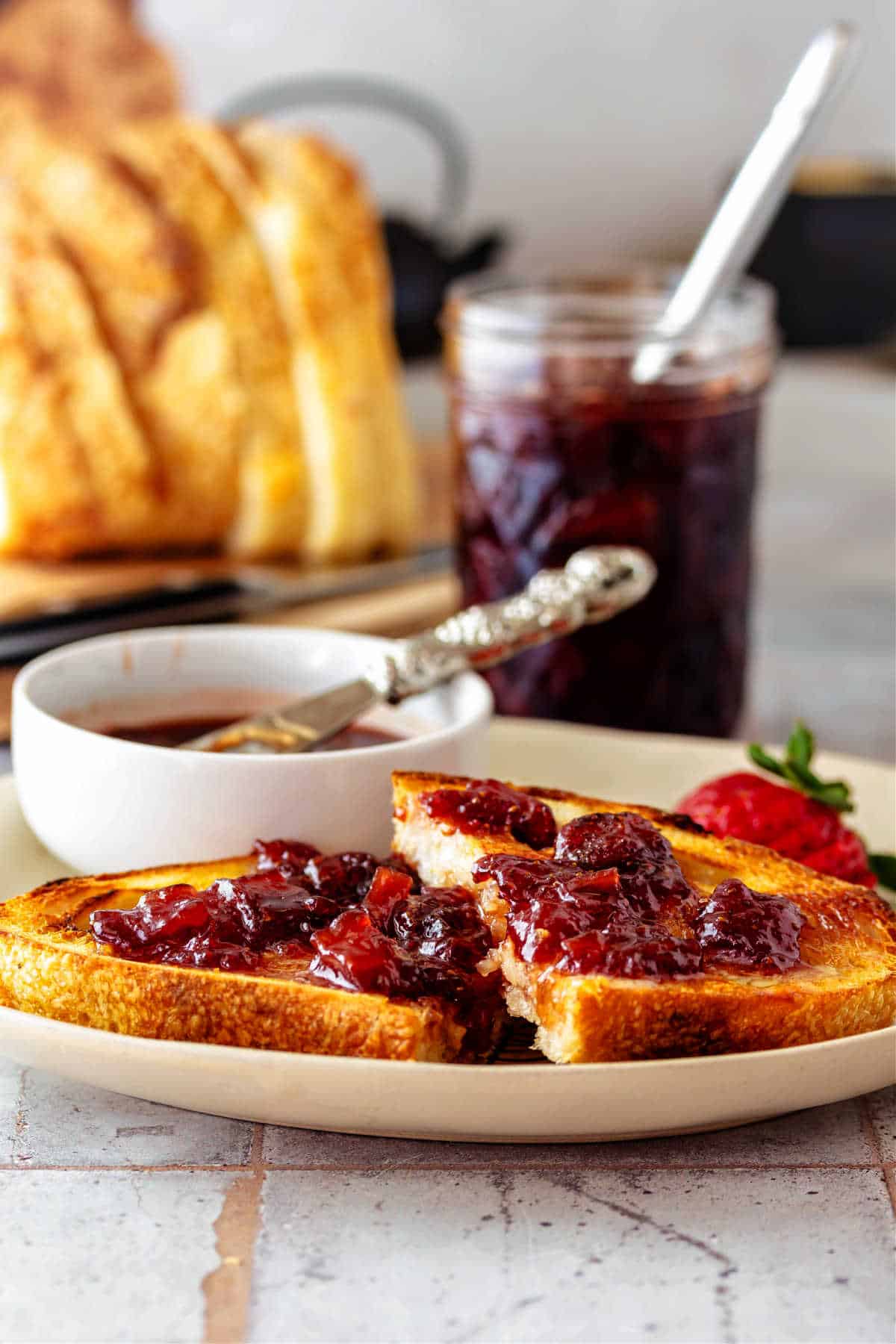
Join in Today!
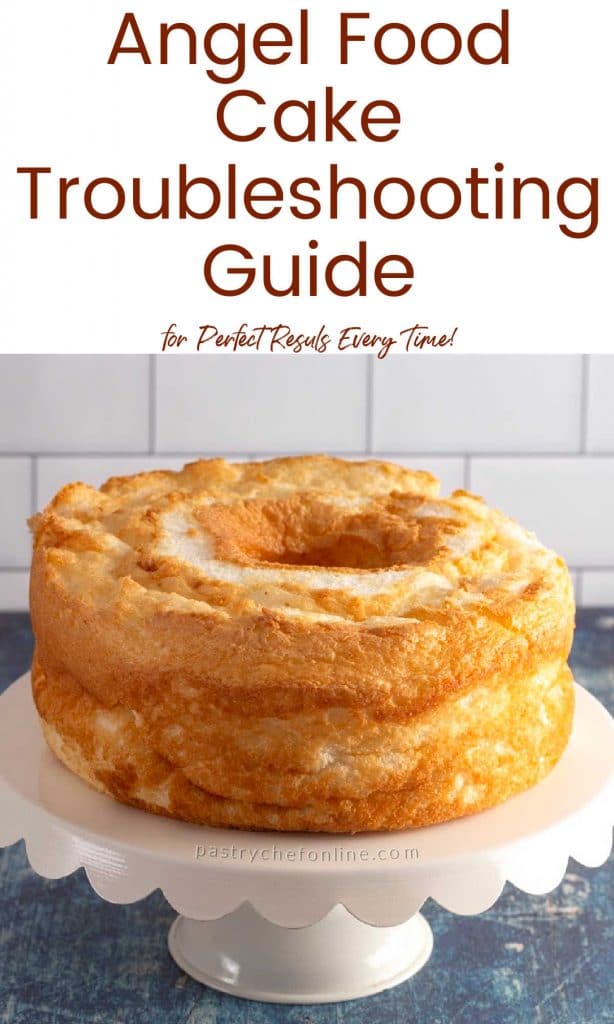
Me chocolate Angel Food Cake rose very well. While cooling, inverted in an angel food cake pan with legs, it had 2 areas on the bottom that had fallen slightly. What could have caused this?
Thanks,
Joyce
Hey, Joyce. It’s possible that the batter was oncompletely mixed so a tiny bit dense in those areas. Overall, it sounds like a success. We’re you still able to use it? And did the texture look different when you sliced into those parts?
Well, another failure with my Angel Food Cake. I changed my salt to regular Morton Salt instead of sea salt, bought McCormick Cream of Tarter. My tube pan was wiped down with vinegar (apple cider because I ran out of white vinegar). By the time I got done with what I was doing and measuring out my other ingredients about 1-1/2 to 2 hrs went by so my eggs was room temperature. The humidity was 40. I bake my cakes on 375 for 35 min or until top springs back when lightly touched per Betty Crockers Instructions. The cake rose so beautifully but a few minutes after inverting it over the bottle it fell. Part was on the pizza pan underneath the bottle and the pan and bottle with the remainder ended up on the floor and the pan bent.
The only thing I can think of is I used the eggs that were just a few days older then my other ones but all was purchased this month so they should have been ok. Come pay day I’m investing in a oven thermometer to make sure my oven is heating up to the 375 degrees and a new pan. Would you have any suggestions on a good oven thermometer, and any other suggestions as to what I can do to prevent this from happening. Thank You for all your previous suggestions.
Oh, Frances, I’m so disappointed it fell again, and it really sounds like you are doing everything right, too.
It’s a good call to check your oven temperature as well as the internal temperature of the cake to make sure it’s completely done. The internal temperature of the cake should be 205F when done, and my preferred instant read thermometer for checking food temp is the Thermapen One. As of right now, they’re on sale too. Affiliate link: https://fave.co/3GbbTNT
Thermoworks doesn’t sell a dedicated oven thermometer, but even one from the grocery store should be able to tell you within 10 degrees or so if your oven thermostat is accurate. Here’s one from Rubbermaid you may want to look at, but most are pretty similar. Affiliate link: https://amzn.to/3WmvMcm
I wish I could help more, but you seriously do seem to be doing everything else correctly.
Help,
My problem just began this evening. I have made many angel food cakes but this evening while it was cooling it separated from the tube pan and broke. I just found out that fresh eggs and room temperature eggs are the best and usually my eggs are really fresh but these were a little older. Also I didn’t invert over a bottle either. Out side of that everything went as usual. Why did my cake give loose doing the cooling period and break apart? Any suggestions would be greatly appreciated.
Hey, Frances, Do you normally invert to cool? Because that would be my first guess as to why your angel food cake slumped and broke. And fresher eggs are less watery than older eggs are, so that also could have thrown off the balance. I would chalk this one up to experience, and if the texture is still good, cut it into chunks and make a trifle with it. I hope that is helpful, because I know how frustrating it can be to have a recipe that usually works just…not…sometimes.
Thank you for your advice and time.
Basically I’ve been making these cakes, Angel Food Waldorf Cake from the Betty Crocker Cook Book, since 1973 and never had this to happen till now. I haven’t inverted over a bottle for a couple years tho because of my good luck with them but I bet I do from now on and from now on will be buying my eggs from the store to insure that they are fresher but at the same time I will even test the eggs in water to make sure that they are really fresh.
Sometimes cakes will just *do* things. I am hoping that with inverting to cool and using super-fresh eggs that you won’t have anymore random fails and you can go back to using that recipe without worry!
Hello! I am a relatively experienced cake baker and had an old (Wilton, maybe?) angel food pan that had ridges on the inside – and even though it had some coating on it, I never had issues with my angel food cakes. Well…the pan started flaking so I tossed it and inherited an aluminum angel food pan. Since then, my cakes do a couple of things – they pull away from the pan (usually when I open the oven to pull) and/or they fall out of the pan. I don’t think I am messing up otherwise – could it be the pan? Or is there something else that might be causing this to happen. It’s getting a tad frustrating and I would buy a pan if I thought it would solve my issues
Hey, Sherrie. I imagine that ridged pan was amazing! If what you’re baking in now is a “raw” aluminum–uncoated, not non-stick–pan, I honestly don’t have any idea. There is no reason a fat-free cake shouldn’t stick to a raw metal surface, and that’s crazy the cake is falling out of the pan. I guess it’s losing height and also getting dense at the same time? Have you played around with oven temps a bit? Maybe 25F up or down could make a difference. Short of that, I’m afraid I don’t have any other great revelations for you, especially considering you are an experienced angel food cake baker. One suggestion just to test the pan: maybe make a different kind of cake in it. Don’t grease the pan, and see if another recipe sticks, like a pound cake or coffee cake. Please report back with any more information. I’d love to help more if I can.
I live at approximately 7,000 ft. Every recipe I follow makes an amazing angel food cake until I take it out of the oven and invert it. It falls out.
I have not greased the pan. I have wiped it with vinegar and let is sit to make sure no residual oils are in the pan.
Frustrating.
Any ideas you have are welcome.
Thank you!
Hi Staci! I am going to refer you to my friend who lives at high altitude and has developed what she says is the perfect high altitude angel food cake. You’re in good hands with Susan. https://thewimpyvegetarian.com/fool-proof-angel-food-cake-even-at-high-altitudes/
Isn’t the “recipe” for half-size angel cake wrong? With a 3:3:1 ratio, shouldn’t it be 6 oz. egg white, 6 oz. of sugar, 2 oz. of cake flour?
You’re correct, Janice. Thanks for catching that. I’ll amend that now! Also note this is a general ratio, and you may have to go up or down a little bit in flour. Your best bet is to find a recipe developed for that size pan, but 3:3:1 should certainly have been 6oz whites:6oz sugar:2 oz cake flour.
6oz sugar is HEAPS of sugar for 2 oz cake flour. Shouldn’t the ratio be 3:1:1??
The ratio is correct. You’re right that it’s a lot of sugar, but the most stable meringue, which is mostly what an angel food cake is, is 2:1 sugar to egg whites. The sugar goes into solution with the water in the whites yielding a thick, marshmallowy meringue that doesn’t break down. Then add in the flour, you need even more sugar to make sure of the stability of the foam. Here is another reference for you: https://www.bakedbyanintrovert.com/angels-food-cake/
Can’t wait to try this! Just to let you know the print button doesn’t work. It just made the page jump around. Tried to print from my tablet, then tried on my computer. Had to highlight the recipe, right click and print it that way. Not a big deal. Just frustrating.
Oh no, I’m sorry! I will let my recipe card folks know you had issues with it. I hope you really enjoy the cake. Tastes like sushine!
OMG, that looks so yummy. Thanks for sharing the recipe and all the tricks. I have never used cake flour before and I have seen it as a ingredient so many times, it may be the simple trick that I have not tried before to make my baked items better.
Cake flour does a great job of giving you a light and tender cake. I hope you give it a try–I use it in all my poundcakes, too!